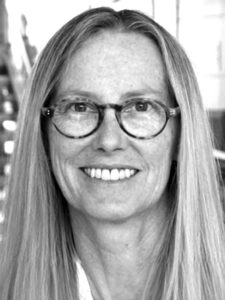Dr. Gill Wright Miller, 1974
B.F.A., Denison University
M.A., Wesleyan University
Ph.D., New York University
Retired Professor
Granville, Ohio
 Having attended Denison as an undergrad, Professor Emerita of Dance and Women’s & Gender Studies Gill Wright Miller began her flourishing full-time teaching presence at the university in 1981.
Having attended Denison as an undergrad, Professor Emerita of Dance and Women’s & Gender Studies Gill Wright Miller began her flourishing full-time teaching presence at the university in 1981.
In a chance meeting with modern dance as an undergraduate at Denison, Gill fell in love with close-witnessing and recording human movement on paper. It gave her, she says, a language to talk about the movement and practice she had learned from her mother who was blind from birth. ‘Dance Notation’ was based on planar and solid geometry, which aligned perfectly with her concurrent coursework in mathematics. The merging of these two fields—movement and mathematics—provided a first-hand example of and appreciation for the unique opportunity offered by liberal arts study. Gill credits this comprehensive educational approach with preparing her thoroughly to pursue a career in dance, movement analysis, and somatics.
After graduating with her Bachelor of Fine Arts in dance performance in 1974, Gill taught briefly as a visiting artist at both Denison and Kenyon Colleges before leaving for New York City and a position at the Dance Notation Bureau. She returned to Columbus as a fully certified notation professional in the early 1980s when a recently named department chair who had requested a year’s delay on her pending contract subsequently declined the offer, positioning Gill to be appointed the new chair. Now finding her career located in academia, she earned a Master of Arts in movement studies from Wesleyan University followed by a Ph.D. in dance education and women’s studies from New York University—all while chairing and teaching fulltime at Denison.
Gill often reveled in teaching interdisciplinary courses, especially those that cross-pollinated aesthetic philosophies with women’s and gender studies. While providing a broad examination of dance and related cultural studies, she often taught on topics such as modernism and postmodernism, the body in performance, and African American concert dance. Whether through the content and methodologies being employed or in the sheer discipline of meeting something new, she routinely encouraged those in her classes to take risks, remain playful, and investigate further with as much physical energy as possible.
Meanwhile, her scholarly research primarily engaged topics of (experiential) somatic exploration, for which she has received notable grants and recognition, and for which she earned the coveted Registered Somatic Movement Educator certification, the field’s highest international honor. She is a published author of several books and many essays, writing on motherhood, creativity and women in dance, and most especially, feminism and somatic praxis.
During her time as a student at Denison, Gill was initiated as a Kappa Kappa Gamma, spent time with 7-year-olds through the LEADS Community Action in Newark, and was a live-in house parent at the Miller Boys Ranch, a home for delinquent high school boys placed there by the Juvenile Detention Center. (She taught high school algebra I and II and geometry, so that the boys could pass their GEDs.) At Denison, she found the same fulfillment in being a Posse Mentor, truly thankful for Denison’s supporting a faculty member spending deep reflective time with a group of students over their four years, regardless of major. Perhaps it was this kind of work that sustained her life-long interest in movement and somatics and the potential the merging of those fields hold for resonance and understanding.
Professionally, Gill strove to move the Dance Department from a vibrant but fledgling neonate in 1972 to a thriving department recognized across the country as the gold standard for liberal arts dance practices to position themselves on the education of whole, well-rounded, respectful ‘creatives’ who have been trained to notice and appreciate the ways in which physical practices introduce us to ourselves, situate us to witness deep cultural variations without judgement, and encourage empathetic response to others.
After more than four decades at Denison, Gill retired in 2022 to complete two book projects (one professional and one genealogical), study Spanish, and enjoy the company of her children and grandchildren. While she retained her home in Granville, she is just as often in New York on the Upper West Side. She also has been very active on her 50th Reunion Committee, assisting especially with creative planning and programming.



